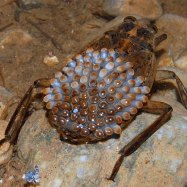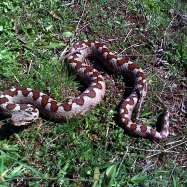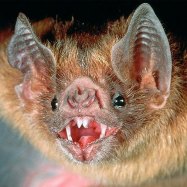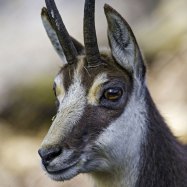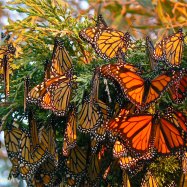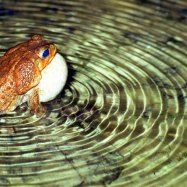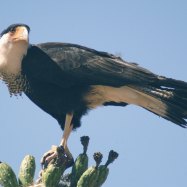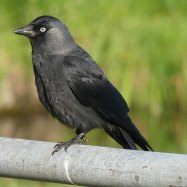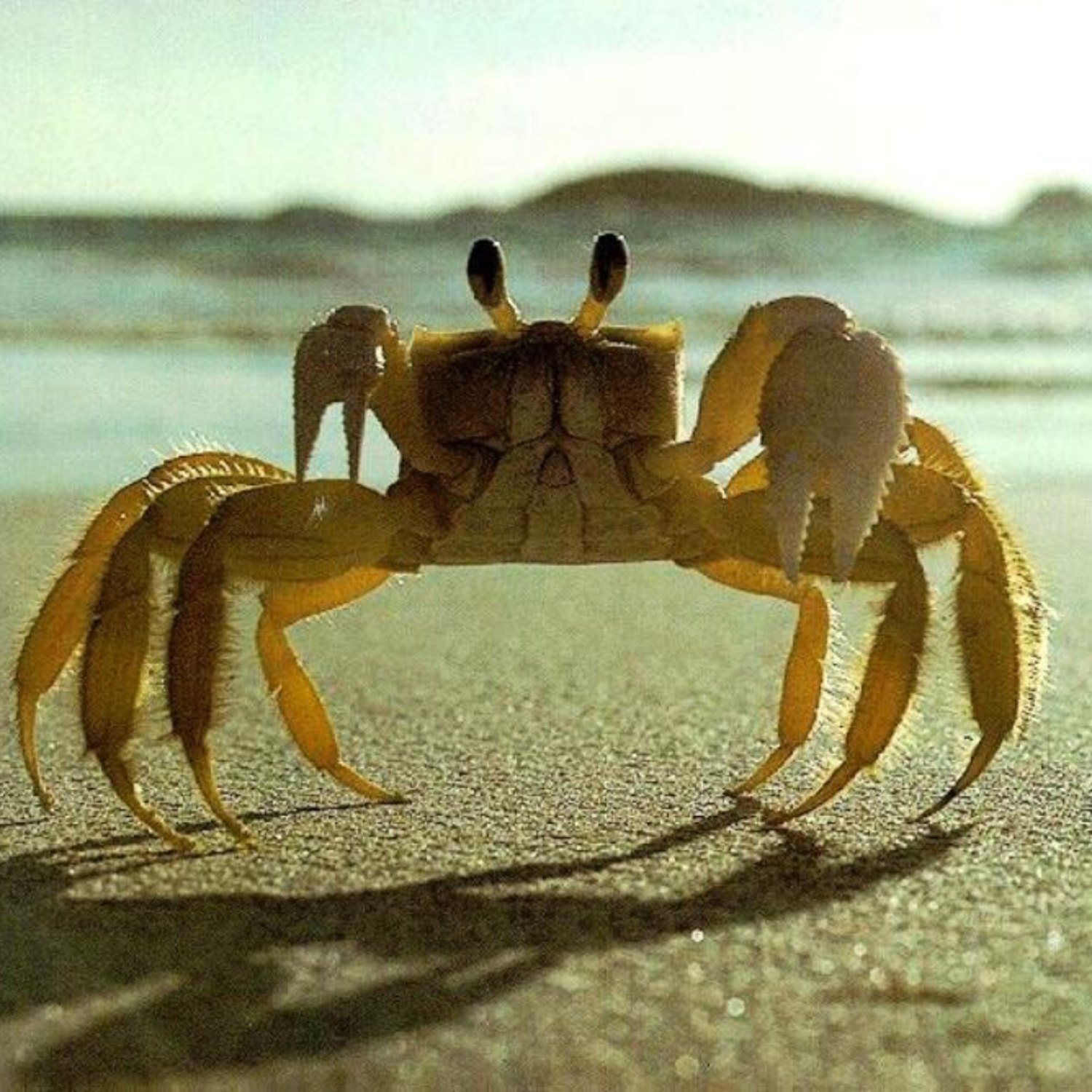
Fiddler Crab
Varies depending on species, ranging from a few centimeters to several inches
Fiddler crabs are fascinating creatures with a unique feature - their asymmetrical claw. They live in coastal areas and come in various sizes. Named 'fiddler' due to their claw resemblance to a violin, these crabs are part of the Ocypodidae family. Have you spotted one on the beach? #FiddlerCrab #CoastalCreatures #UniqueClaws
Animal Details Summary:
Common Name: Fiddler Crab
Kingdom: Animalia
Habitat: Coastal habitats such as sandy or muddy beaches, mangroves, and salt marshes
Introduction
On a peaceful, sandy beach, where the ocean meets the land, there is a busy little creature scurrying around. With one oversized claw in the air, it looks like it's waving hello. This colorful and interesting animal is known as the Fiddler Crab.Fiddler crabs, or Uca, are a genus of crabs found worldwide in tropical and subtropical regions Fiddler Crab. They are well-known for their distinct asymmetrical claw, which resembles a fiddler playing its instrument, hence their name. These crabs live in coastal habitats such as sandy or muddy beaches, mangroves, and salt marshes, and play a vital role in maintaining the health of these ecosystems. Let's dive deeper into the fascinating world of the fiddler crab.
Classification and Taxonomy
Being part of the animal kingdom, the Phylum Arthropoda, and the Class Malacostraca, fiddler crabs share common traits with other crustaceans such as shrimps, lobsters, and barnacles. They belong to the Order Decapoda, which includes ten legs, and their distinctive claw dictates their suborder, Brachyura, which translates to "short-tailed." This claw is typically larger than the crab's body and can be either on the left or the right side.Under the family Ocypodidae, there are around 100 recognized species of fiddler crabs, with more still being discovered. They are small in size, with some species measuring only a few centimeters in length, while others can reach up to several inches.
Their unique scientific name, "Uca," comes from the Latin word "uca" meaning "skirt" or "overgrown Fur Seal."
Habitat and Distribution
Fiddler crabs are found worldwide in tropical and subtropical regions, with different species inhabiting different locations. They are commonly found in coastal areas such as sandy or muddy beaches, mangroves, and salt marshes.Their preferred habitat is a tidal flat, where they can dig burrows and use them for protection and shelter. These burrows also provide a safe spot for the crabs to molt, the process of shedding their hard exoskeleton and growing a new one.
Coloration and Body Shape
Fiddler crabs come in various colors and patterns, with some species being more brightly colored than others. Their coloration helps them blend in with their environment and avoid predators.Typically, fiddler crabs are earth-toned, with shades of brown, green, or gray. However, some species have vibrant blue or orange-colored body parts, making them stand out among their peers.
Their body is compact and flattened, with a hard exoskeleton that protects them from predators. They have small eyes located on eyestalks and four pairs of legs, with the first pair being much larger and more dominant. The oversized claw can be used for communication, courtship, and to defend their territory.
Feeding Method
As omnivores, fiddler crabs have a diverse diet consisting of detritus, algae, and small invertebrates. They use their smaller claw, also known as the feeding claw, to scoop up food from the sand and transfer it to their mouth.Fiddler crabs play an essential role in their ecosystem by helping to aerate the sand and recycle organic material. Their feeding habits also contribute to the growth of bacteria, which serves as a food source for other creatures in the habitat.
Social Structure
Fiddler crabs are social creatures, and they live in large groups called colonies, consisting of hundreds to thousands of individuals. These colonies are usually dominated by one male crab, known as the alpha. The other crabs in the colony are mostly females and juvenile males.Male fiddler crabs compete for mating rights with the females by waving their large claw and performing "dances." The females choose their mate based on the male's size and the quality of his burrow.
Adaptations and Behaviors
Fiddler crabs have unique adaptations and behaviors that help them survive in their environment. One of their most notable adaptations is their ability to breathe through their gills, even when their burrow is filled with water during high tide.Their burrowing behavior also helps them avoid predators by providing a quick escape route. They are also experts at camouflage, using their body coloration to blend in with their surroundings and avoid being preyed upon.
When threatened, fiddler crabs will use their large claw as a defense mechanism. They can also wave their claw as a warning to other crabs and to communicate. The waving of the claw also serves to attract potential mates and establish dominance in the colony.
Conservation Status
Fiddler crabs play a vital role in maintaining the health of coastal habitats. However, they face various threats that can potentially harm their population and the ecosystems they inhabit.One of the significant threats to fiddler crabs is habitat destruction. With the increasing development and urbanization of coastal areas, their habitats are being destroyed or disrupted, affecting their ability to survive.
Pollution, particularly plastic pollution, is also harmful to fiddler crabs. These small creatures can easily mistake small plastic pieces for food, which can lead to injury or death.
Another threat to fiddler crabs is overharvesting for the aquarium trade and for use as bait in fishing. These activities can impact the natural balance of their populations, affecting other animals in their habitat.
Therefore, it is essential to protect the coastal habitats where fiddler crabs thrive and to practice sustainable harvesting methods to ensure their survival.
Conclusion
Fiddler crabs may be small creatures, but they play a significant role in the coastal ecosystems they inhabit. With their unique appearance, behaviors, and adaptations, they are truly fascinating animals to observe.From their colorful body to their waving claw, the fiddler crab is a delightful addition to the diverse world of crustaceans. As humans, it is our responsibility to protect and preserve these creatures' habitats to ensure that they continue to thrive for generations to come. So next time you visit a coastal area, keep an eye out for these charming little fiddlers and appreciate their vital role in our oceans.

Fiddler Crab
Animal Details Fiddler Crab - Scientific Name: Uca
- Category: Animals F
- Scientific Name: Uca
- Common Name: Fiddler Crab
- Kingdom: Animalia
- Phylum: Arthropoda
- Class: Malacostraca
- Order: Decapoda
- Family: Ocypodidae
- Habitat: Coastal habitats such as sandy or muddy beaches, mangroves, and salt marshes
- Feeding Method: Omnivorous, feeding on detritus, algae, and small invertebrates
- Geographical Distribution: Found worldwide in tropical and subtropical regions
- Country of Origin: Varies depending on species
- Location: Coastal areas
- Animal Coloration: Varies depending on species, typically earth tones such as brown, green, or gray
- Body Shape: Compact and flattened body with a distinct asymmetrical claw
- Length: Varies depending on species, ranging from a few centimeters to several inches
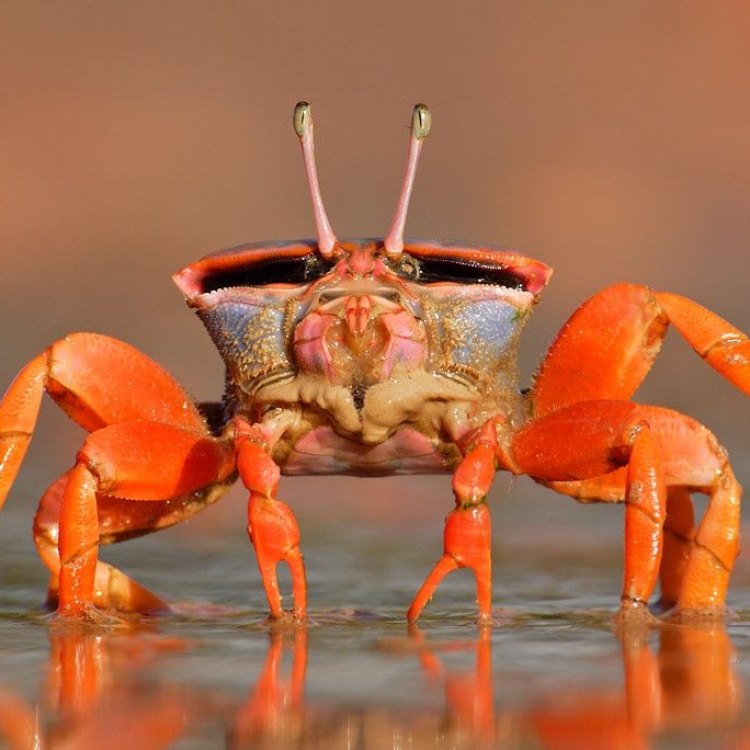
Fiddler Crab
- Adult Size: Varies depending on species, ranging from a few centimeters to several inches
- Average Lifespan: Varies depending on species, typically 1-3 years
- Reproduction: Sexual reproduction
- Reproductive Behavior: Males attract females with waving display of their large claw
- Sound or Call: Males use drumming sounds produced by their claw to communicate
- Migration Pattern: Some species undergo short-distance migrations
- Social Groups: Males defend territories and form hierarchies, females and juveniles live in burrows
- Behavior: Active during the day, burrow in mud or sand, come out during low tide to forage
- Threats: Habitat loss, pollution, predation
- Conservation Status: Varies depending on species, some are of conservation concern
- Impact on Ecosystem: Important for sediment stabilization, nutrient cycling, and ecosystem functioning
- Human Use: Used in aquaculture and as bait for fishing
- Distinctive Features: Asymmetrical claw, wide and flattened body
- Interesting Facts: The larger claw of the male fiddler crab is mainly used for communication and courtship rather than defense. Females prefer males with larger claws.
- Predator: Birds, fish, larger crabs
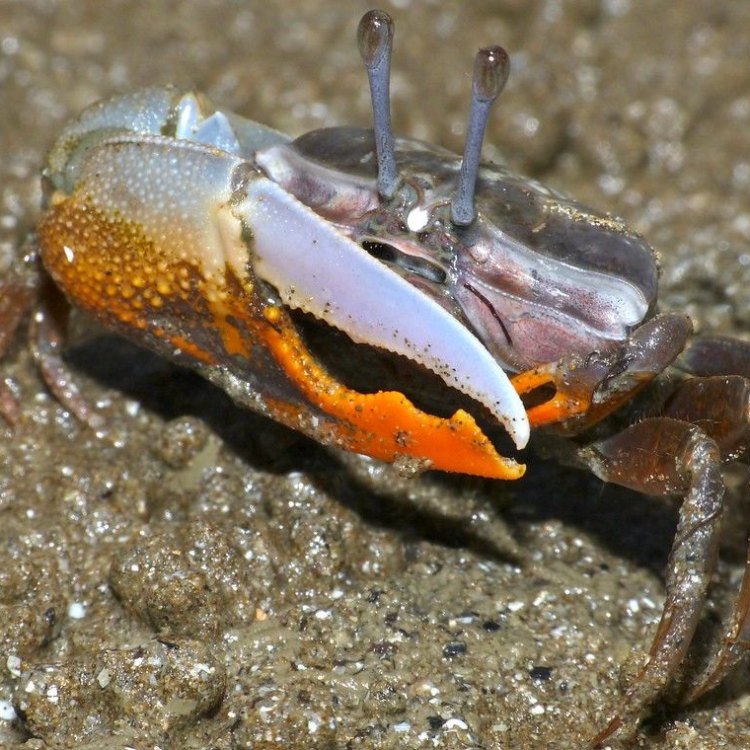
Uca
The Fascinating World of Fiddler Crabs: From Courtship Rituals to Ecosystem Engineers
The beach is a popular spot for sunbathing, swimming, and building sandcastles. But if you take a closer look at the sand, you may notice tiny creatures scurrying around, leaving small holes and mounds in their wake. These are fiddler crabs, fascinating creatures with unique features and behaviors that make them stand out in the vast world of crustaceans.Fiddler crabs, also known as calling crabs or violin crabs, are small-sized crabs that inhabit intertidal zones, mostly found in mangroves, mudflats, and sandy or muddy shores PeaceOfAnimals.Com. They are found on all continents except for Antarctica, and their habitats range from tropical to temperate regions.
Adult fiddler crabs vary in size depending on the species, ranging from a few centimeters to several inches. They have an average lifespan of 1-3 years, with some species living longer than others. These crustaceans are known for their reproductive behavior and unique physical features that make them a vital part of their ecosystem.
The Mating Dance: Courtship Rituals of Fiddler Crabs
Fiddler crabs are sexual reproducers, meaning they require a male and female to breed. During the mating season, male fiddler crabs use their larger claw, also known as the major claw, to attract females. This claw can be up to 10 times larger than the crab's body and is used to wave and drum in the air, creating a visual display and a distinctive sound that can be heard up to 30 meters away.The unique thing about fiddler crabs is that the larger claw is not primarily used for defense against predators, like other crabs. Instead, it is mainly used for communication and courtship rituals Ferruginous Hawk. The drumming sound produced by the claw serves as a signal to females that the male is ready for mating.
Interestingly, female fiddler crabs prefer males with larger claws, as it signifies better health and genetic compatibility. This preference has led to an interesting evolutionary consequence, resulting in males evolving asymmetrical claws. The larger claw is called the chela, and the smaller one is called the minor claw. The chela is usually on the left side, making the fiddler crab look almost like a one-handed creature.
Active Ecosystem Engineers: Impact on Surrounding Environment
Besides their unique courtship rituals, fiddler crabs play a significant role in their ecosystem as ecosystem engineers. These small creatures may not seem like much, but their presence is crucial for the overall health and functioning of their environment.Fiddler crabs help stabilize the sediment on muddy shores by creating burrows. These burrows allow water and air to flow, making it easier for oxygen to reach the sediment. This process is beneficial for filtering out nutrients, which are then consumed by the crabs and other organisms in the area.
The burrowing and feeding activity of fiddler crabs also helps with nutrient cycling, as they act as nutrient processors, breaking down organic matter and redistributing it throughout the ecosystem. This helps maintain a healthy balance of nutrients, which is crucial for the growth and survival of other organisms in the area. Additionally, the burrows created by fiddler crabs serve as shelter for other small creatures, helping them avoid predators and harsh environmental conditions.
Threats to Fiddler Crabs and Conservation Efforts
Like many other species, fiddler crabs face numerous threats, including habitat loss, pollution, and predation. Habitat loss due to coastal development and pollution from human activities such as industrial waste and oil spills can greatly impact the survival of fiddler crabs, as it destroys their natural habitat and reduces the availability of food and resources.Predation by birds, fish, and larger crabs is also a significant threat to fiddler crabs, especially during the mating season when they are more exposed while performing their courtship rituals. This is why fiddler crabs have evolved to be active during the day and seek shelter in their burrows during high tide, minimizing their exposure to predators.
The conservation status of fiddler crabs varies depending on the species, with some being classified as of conservation concern. In areas where fiddler crabs are heavily impacted by human activities, conservation efforts are being made to protect their habitats and preserve their populations. Raising awareness about the importance of these small creatures in their ecosystem is also crucial in promoting their conservation.
Human Use of Fiddler Crabs
Fiddler crabs have also been of use to humans in various ways. In some parts of the world, they are used in aquaculture, where they are raised for food or as bait for fishing. However, overharvesting of fiddler crabs can have detrimental effects on their populations and ecosystem as a whole.In traditional medicine, fiddler crabs have been used to treat various ailments, from respiratory problems to stomach issues. However, there is no scientific evidence to support these claims, and further research is needed to understand the potential benefits and risks of using fiddler crabs in traditional medicine.
Intriguing Physical Features and Behavior of Fiddler Crabs
Apart from their unique courtship rituals and importance in their ecosystem, fiddler crabs also stand out due to their distinctive physical features and behavior.You may have noticed that fiddler crabs have wide, flattened bodies, giving them a distinct shape. This body shape helps them move efficiently through muddy and sandy environments and also helps them burrow into the sediment easily.
Fiddler crabs are also known to undergo short-distance migrations, moving to different parts of their habitat in search of food, mates, or better environmental conditions. This behavior is mostly seen in species inhabiting mangrove forests, where tides are frequent and can affect their survival.
In Conclusion
Fiddler crabs may be small creatures, but they play a significant role in their environment. From their fascinating courtship rituals to their importance as ecosystem engineers, these tiny creatures are vital for maintaining the balance in their habitats. With increasing threats to their survival, it is crucial to raise awareness and promote conservation efforts to protect these unique and intriguing crustaceans for generations to come. So, the next time you spot a fiddler crab on the beach, take a moment to appreciate the wonders of nature and the important role these small creatures play in it.
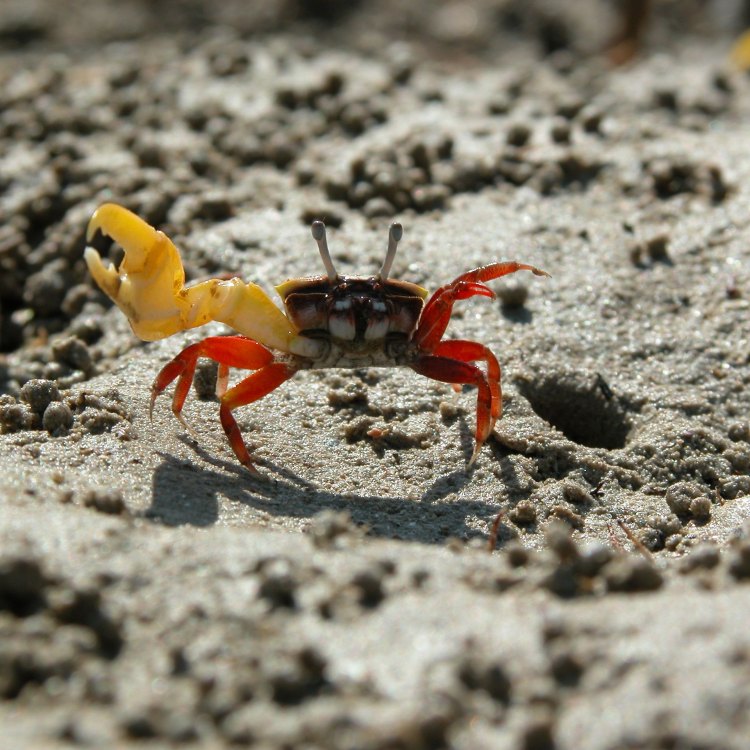
Introduction
Disclaimer: The content provided is for informational purposes only. We cannot guarantee the accuracy of the information on this page 100%. All information provided here may change without prior notice.

